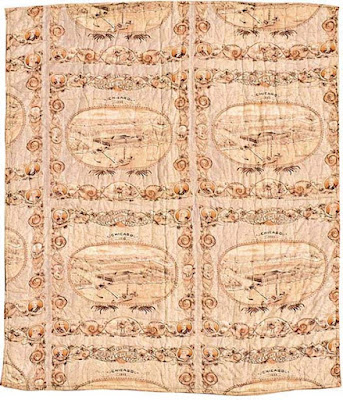Chicagoans viewing the Lake from downtown today can hardly imagine what it all looked like in summer, 1893 when dozens and dozens of fanciful yet substantial buildings constructed for a six-month event stood in Jackson Park.
The buildings of the White City interpreted the Beaux-Arts classical look as spun sugar but most of the structures were actually of concrete and hemp.
Only one remains 130 years later, the Museum of Science & Industry.
The Kansas Building
The German-speaking Chicago Columbian Club still meets.
In the early 1890s they formed Women's Columbian Clubs dedicated to fundraising for buildings, shipping and selecting and commissioning exhibits.
Many works of art were commissioned especially
for the fair. We hope Bertha Palmer and Candace Wheeler
never happened upon the Emporia Fountain in the Kansas Building.
Iowa set aside $20,000 for women's work which included
"Fancy work for home use, comfort or ornamentation."
This does not reflect the elitism we saw yesterday in the Women's
Building displays.
For years leading up to the fair various committees, self-appointed
and official, solicited entries to fill their state display areas.
This unofficial committee in Georgia made plain their attitude
about quilts offered to them and did not mince words:
"Ques- I have a patchwork quilt containing 3,000 pieces,etc.
Ans. Don't want it."
However, it seems that many state displays included quilts and a few recorded them. The book Kansas at the World's Fair tells us about needlework. The Woman's Columbian club of Holton showed lace. Mrs. A.C. Cowles of Emporia showed a "crazy-work throw and Mrs. E.E. Crandall of Manhattan sent a patchwork quilt."
In 1984 the Green Bay Wisconsin Press Gazette published
a story about this family crazy quilt telling us that it was made for and
displayed at the 1893 Fair.
More about the Chamberlin quilt
March, 1893 article from the Davenport, Iowa Leader
There's no way to corroborate the story that the crazy quilt was shown in the Iowa building, but after working on this kind of question all week I can only say: It's possible.
And that is just about the only conclusion we can draw about quilts actually shown at the 1893 expo.
Many quilts were made as souvenirs, some pieced of handkerchiefs sold at the fair like this one from the collections at Michigan State University.
But quilts made AFTER the fair is another topic.
Women's Columbian Club in Boise, Idaho
And we are finished with posts on quilts shown at the Columbian Exposition (for now.)



















My knowledge of this World's Fair comes from my study of a Texas woman who was active in politics and women's clubs during this period. I know that she traveled from Texas to visit the fair. She was a major player in the women's clubs in Texas and that is probably what proved the draw for her to make the journey. Very interesting. Thanks.
ReplyDelete